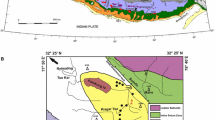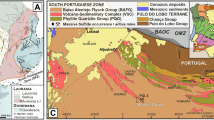Abstract
Rhyolite from the Deh Salm area, Lut block, Iran, is a 10-km-long flow unit that crops out as a 6-m thick sub-horizontal sheet (<5° dip) underlain by agglomerate and overlain by crystal lithic tuff. The ryholite contains phenocrysts of garnet, plagioclase and amphibole phases residing in a cryptocrystalline groundmass consisting of plagioclase, K-feldspar and quartz. Euhedral garnet phases range in size from 0.2 to 3.0 mm, have inclusions of ilmenite, rutile, apatite and zircon, and show no reaction/resorption microtextures. Electron microprobe analysis reveals that the garnet is homogeneous, lacks substantial chemical zoning and is dominantly almandine with subordinate pyrope, grossular, spessartine and andradite. The absence of inclusions of metamorphic minerals within garnet as well as the lack of included metamorphic rock fragments in the host rhyolite rule out a xenocrystic origin for the garnet. The garnet phases have low CaO content and variable MnO concentration, resembling those formed from S-type magma. The host rhyolite contains quartz, K-feldspar, and amphibole, has normative corundum, and is peraluminous. Inclusions within garnet as well as the chemistry of the garnet and the host rhyolite suggest that the garnet is a phenocryst phase crystallized from a deep-rooted (>25 km) crustal-derived peraluminous magma. It is likely that the peraluminous feature of the magma, inherited from partial melting of metapelitic source rocks, has favoured crystallization of garnet. Upon rising to higher levels, the garnet phases were in equilibrium with the host magma and thus were preserved as relatively large euhedral crystals in the Deh-Salm rhyolite.




Similar content being viewed by others
References
Akrami AM, Naderi N (2005) Geological map of Deh Salm. 1:100,000 scale. Geolog Surv Iran
Birch WD, Gleadow AJD (1974) The genesis of garnet and cordierite in acid volcanic rocks: Evidence from the Ceberean Cauldron, central Victoria, Australia. Contrib Mineral Petrol 45:1–13
Clemens JD, Wall VJ (1984) Origin and evolution of a peraluminous silicic ignimbrite suite: the Violet Town Volcanics. Contrib Mineral Petrol 88:354–371
Chappell BW, White AJR (1974) Two contrasting granite types. Pacific Geol 9:173–174
Conrad WK, Nicholas IA, Wall VJ (1988) Water-saturate and -undersaturated melting of metaluminous and peraluminous crustal compositions at 10 kb: evidence for the origin of silicic magmas in the Taupo Volcanic Zone, New Zealand and other occurrences. J Petrol 29:765–783
Dahlquist JA, Galindo C, Pankhurst RJ, Rapela CW, Alasino PH, Saavedra J, Fanning CM (2007) Magmatic evolution of the Peñón Rosado granite: petrogenesis of garnet-bearing granitoids. Lithos 95:177–207
Davoudzadeh M, Schmidt K (1984) A review of the Mesozoic paleogeography and paleotectonic evolution of Iran. Neues Jb Geol Paläont Mh 168:182–207
Davoudazdeh M, Soffel H, Schmidt K (1981) On the rotation of the Central-East-Iran microplate. Neues Jb Geol Paläont Mh 160:180–912
Day RA, Green TH, Smith IEM (1992) The origin and significance of garnet phenocrysts and garnet-bearing xenoliths in Miocene calc-alkaline volcanics from northland, New Zealand. J Petrol 33:125–261
Esmaiely D, Nédéléc A, Valizadeh MV, Moore F, Cotton J (2005) Petrology of the Jurrasic Shah-Juh granite (eastern Iran), with reference to tin mineralization. J Asian Earth Sci 25:961–980
Fitton JG (1972) The genetic significane of almandine-pyrope phenocrysts in the calc-alkaline BorrowdaleVolcanic Group, Northern England. Contrib Mineral Petrol 36:231–248
Gilbert JS, Rogers NW (1989) The significance of garnet in the Permo-Carboniferous volcanic rocks of the Pyrenees. J Geol Soc London 146:477–490
Green TH (1976) Experimental generation of cordierite- or garnet-bearing granitic liquid from a pelitic composition. Geology 4:85–88
Green TH (1977) Garnet in silicic liquids and its possible use as a P–T indicator. Contrib Mineral Petrol 34:150–166
Green TH (1992) Experimental phase equilibrium studies of garent-bearing I-type volcanics and high-level intrusives from Northland, New Zealand. Trans Royal Soc Edinburgh, Earth Sci 83:423–438
Green TH, Ringwood AE (1968) Origin of garnet phenocrysts in calc-alkaline rocks. Contrib Mineral Petrol 18:163–174
Green TH, Ringwood AE (1972) Crystallization of garnet-bearing rhyodacite under high-pressure hydrous conditions. J Geol Soc Austral 19:203–212
Harangi SZ, Downes H, Kósa L, Szabó CS, Thirwall MF, Mason PRD, Mattey D (2001) Almandine garnet in calc-alkaline volcanic rocks of northern Panonnian basin (east-central Europe): geochemistry, petrogenesis and geodynamic implications. J Petrol 42:1813–1843
Hensen DJ, Green DH (1973) Experimental study of the stability of cordierite and garnet in pelitic compositions at high pressures and temperatures. Contrib Mineral Petrol 38:151–166
Jung D, Keller J, Khorasani R, Markcs C, Baumann A, Horm P (1983) Petrology of the Tertiary mgmatic activity in the northern Lut area, east of Iran. Geodynamic project (Geotraverse) in Iran. Report No. 51. Geol Surv Iran 284–336
Kawabata H, Takafuji N (2005) Origin of garnet crystals in calc-alkaline volcanic rocks from the Setouchi volcanic belt, Japan. Mineral Mag 69:159–179
Keesmann I, Matthes S, Schreyer W, Seifert F (1971) Stability of almandine in the system FeO–(Fe2O3)–Al2O3–SiO2–(H2O) at elevated pressures. Contrib Mineral Petrol 31:132–144
Kluyver HM, Griffis RJ, Tirrul R, Chance PN, Meixner HM (1983) Explanatory text of the Lakar Kuh quadrangle map, 1:250,000 scale. Geol Surv Iran 175:1–20
Lantai C (1991) Genesis of garnets from andesite of Karanca Mountains. Acta Geolog Hungarica 34:133–154
Le Maitre RW (2002) Igneous rocks. A classification and glossary of terms. Cambridge University Press, Cambridge
McDonough WF, Sun SS (1995) Composition of the Earth. Chem Geol 120:223–253
Mitropoulos P, Katerinopoulos A, Kokkinakis A (1999) Occurrence of primary almandine–spessartine-rich garnet and zinnwaldite phenocrysts in a Neogene rhyolite on the island of Chios, Aegean Sea, Greece. Mineral Mag 63:503–510
Nogol-Sadat MAA (1978) Les zones de decrochement et les virgations structurales en Iran. Concequences des resultants de l’analysis structurale de la region de Qom. These Univ Scientifique de Medicate de Grenoble 201
René M, Stelling J (2007) Garnet-bearing granite from the Třebíč pluton, Bohemian Massif (Czech Republic). Mineral Petrol 99:55–69
Rickwood PC (1968) On recasting analyses of garnet into end-member molecules. Contrib Mineral Petrol 18:175–198
Stöcklin E, Eftekharnejad G, Hoshmandzadeh A (1971) Initial investigation of central Lut block, eastern Iran. Geol Surv Iran, Report No. 22: 88
Takin M (1972) Iranian geology and continental drift in the Middle East. Nature 235:147–150
Tirrul R, Bell LR, Grrifis RJ, Camp VE (1983) The Sistan suture zone of eastern Iran. Geol Soc Am Bull 84:134–150
Wood CP (1974) Petrogenesis of garnet-bearing rhyolites from Canterbury, New Zealand. New Zealand J Geol Geophys 17:759–787
Zeck HP (1970) An erupted migmatite from Cerro de Hoyazo, SE Spain. Contrib Mineral Petro 26:225–246
Acknowledgments
Keith Bell is thanked for reading an earlier version of this paper. Help by Peter Jone for microprobe analysis is appreciated. We would like to thank Kurt Stuewe, and the two reviewers, Eugenio Fazio and Tim Johnson, whose comments added greatly to this manuscript. This work was financially supported by the research council of the University of Tehran, grant number 27838/1/10 to H. Mirnejad.
Author information
Authors and Affiliations
Corresponding author
Additional information
Editorial handling: K. Stüwe
Rights and permissions
About this article
Cite this article
Mirnejad, H., Blourian, G.H., Kheirkhah, M. et al. Garnet-bearing rhyolite from Deh-Salm area, Lut block, Eastern Iran: anatexis of deep crustal rocks. Miner Petrol 94, 259–269 (2008). https://doi.org/10.1007/s00710-008-0015-4
Received:
Accepted:
Published:
Issue Date:
DOI: https://doi.org/10.1007/s00710-008-0015-4




